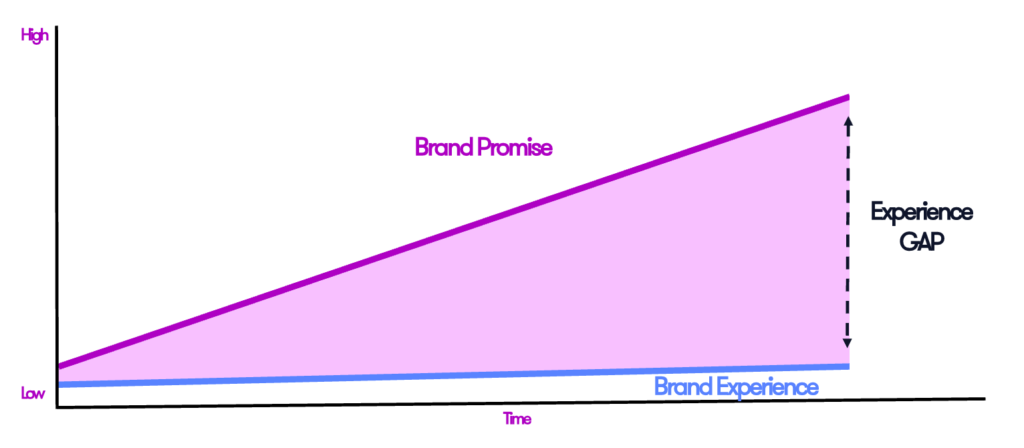BLOG
The experience gap

Brand value is game-changing. It is by far one of the most important things a company can build. It’s a core part of the CMO’s mission. And when done correctly, brands reap the benefits of being top-of-mind when it comes to consumer awareness, including the ability to sell more products and services at a premium. Valued brands have a clear competitive advantage while building a deep moat. Lastly, the most iconic brands with the highest brand value also benefit from a deep pool of talent because people want to work for iconic names.
Brand Finance has released their global ranking based on brand value for 2022: the top 10 brands are Apple, Amazon, Google, Microsoft, Walmart, Samsung Group, Facebook, ICBC, Huawei, and Verizon.
These brands are admired by competitors and consumers globally. The level of consumer awareness around each of these brands is high, and the average consumer engages with at least three to four of these brands’ products, services, and/or software on a daily basis. Each of these brands continues to advance their staying power despite macro-economic pressures.
What is brand value?
Brand value goes beyond a company’s logo and color scheme. Your company’s brand is the soul of the organization. It defines your mission, values, and purpose. It’s how your customers and employees connect on a deeper level, well beyond a product or service. A brand is hard to create, harder to deliver on, and the staying power of your organization depends on it.
I have been fortunate enough to work with more than 200 brands across the world, all of which have made Brand Finance’s list in 2022. As a matter of fact, most of these brands have been on the list for more than five consecutive years. I firmly believe that what all of these brands have in common is a thorough understanding of “The Experience Gap.”

Brand Promise sets the expectations for your customers and employees. This is the story or narrative your brand wants customers and employees to experience. It’s the promise that, when delivered, creates the emotional connection – trust, love, and loyalty – all brands aspire to have with their customers and employees.
Brand Experience is the sum of the interactions your customers and employees actually have with your brand. These interactions are the moments of truth for your brand: it is within these moments that stories – both positive and negative – are created and shared by customers and employees.
The Experience Gap is an accumulation of millions, if not billions, of stories told by a brand’s customer and employee base every day.
These stories can have positive sentiments that express love and loyalty, derived from employees connecting with customers: “Johnnie was so attentive to our needs.” “Susie empowered me with style recommendations, and I feel more confident and beautiful when I go to work.” These stories create trust, which facilitates love for the brand and a strong emotional connection that strengthens loyalty.
On the flip side, these stories can have negative sentiments attached: “I can never find my size when I visit the store, and it’s always hard to get help.” “The website is hard to navigate, and I can never find what I am looking for.” These stories erode customer trust. They create negative brand equity as customers continue to repeat these stories whenever a brand is mentioned by a friend, family member, or colleague.
Although brands want to control the narrative, it is very evident they are not in control. Customers and employees control the stories surrounding a brand. The ease of creating a video and posting it on social media or writing a poor Google Review has placed control in customers’ and employees’ hands.
How can a brand ensure the story they want to be told is told?
1) Acknowledge your brand is not in control: No matter how much money a brand invests in controlling the narrative, it will never be in control of customer and employee stories. And that’s a good thing.
2) Build experience systems: The CMO (Chief Marketing Officer) and CXO (Chief Experience Officer) should be joined at the hip. The CMO defines the brand promise and tells the story of what customers can expect from the company. The CXO measures the brand experience. Together, they form a team to connect the dots and influence internal stakeholders to take action when the brand promise is not fulfilled. Experience systems enable brands to connect with the customer, resolve the issue, and tell a new story. These systems empower internal teams to take action in order to improve on how the brand delivers on its promise. This could be through coaching and upskilling frontline retail employees, optimizing the website for a more seamless online shopping experience, or changing an outdated return policy.
3) Focus on connection: Stories are told on various channels. Empower your customers by giving them a voice, but most importantly, connect with your customers. Understand their experience. Listen to them to ensure you not only understand the experience, but also how it made them feel. Loyalty is rooted in connection.
4) Own the story: Brands always want to amplify the positive, heart-warming stories customers and employees share on social media. They re-share and utilize these stories in campaigns. However, all too often, brands fail to own negative stories. They blame the experience on macro-economic pressures like the supply chain instead of finding solutions for their customers. Owning the negative stories empowers your organization to change the narrative by delivering great experiences.
Take Domino’s Pizza for example. It’s an oldie but a goodie: in 2009, the international chain launched a massive marketing campaign that celebrated customer complaints as a lever for improvement. In “The Domino’s Pizza Turnaround,” a micro-documentary associated with the campaign, the opening scene is a montage of terrible feedback about their pizza. The rest of the doc is just as self-deprecating. The message: not only do we hear you and acknowledge your dissatisfaction, but we are also aware enough to laugh at ourselves along the path to improvement. Public reception for the #newpizza campaign was phenomenal, and Domino’s was able to save their ship from sinking.
Every action (or inaction) your brand takes to close The Experience Gap by improving the experience for customers and employees is a way for your brand to live up to its promise. The Experience Gap is where a brand’s equity can be realized. It’s where connections with customers are made at a deep and foundational level – the soul. The Gap is where brand loyalty and all subsequent business successes (wallet share, customer lifetime value, etc.) are truly realized.
Closing The Experience Gap is how brands ensure the story that is being told about them is positive. Storytelling is the greatest factor in customer loyalty and business, yet too many executives don’t understand how to measure the impact of positive and negative stories. The consequence of not delivering on your brand’s promise and not taking action to close The Experience Gap is that your brand loses its soul.
Chat with Zack! text XM to 20404 and share your biggest take-away from this blog.
Want to Chat some more? Click Here to schedule a 30-minute session with Zack.
Connect with Zack for a chat
Zack Hamilton
Senior Vice President, Chief Experience & Strategy
![]()
![]()
